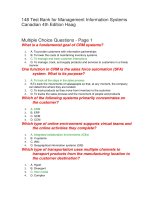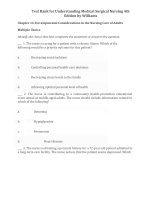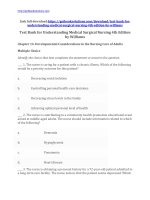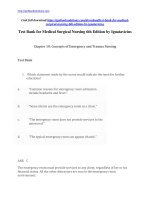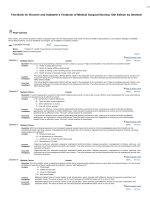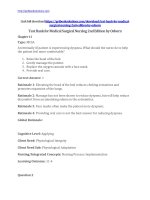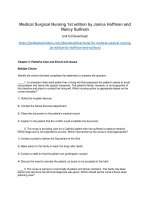Test bank for understanding medical surgical nursing 4th edition by williams
Bạn đang xem bản rút gọn của tài liệu. Xem và tải ngay bản đầy đủ của tài liệu tại đây (77.67 KB, 9 trang )
Full file at />
Chapter 1. Critical Thinking and the Nursing Process
Multiple Choice
Identify the choice that best completes the statement or answers the question.
____ 1. While providing care on a medical unit, which of the following patients should the LPN/LVN see
first?
a. A patient who has a temperature of 106°F (41.1°C)
b. A patient who needs assistance to ambulate
c. A patient who needs discharge teaching
d. A patient who states, “No one cares about me”
____
2. During a class discussion, one nursing student states belief in the practice of restraining patients.
Another student has presented information regarding the unrestrained environment. Both students
understand each other’s points of view. This is an example of what component of critical thinking?
a. Intellectual empathy
b. Intellectual integrity
c. Intellectual courage
d. Intellectual sense of justice
____
3. Which of these human needs is being met when staff members have a potluck dinner with a
congratulatory cake for a newly licensed practical nurse?
a. Physiological
b. Safety and security
c. Self-esteem
d. Self-actualization
____
4. The nurse is caring for a patient with a newly fractured femur who reports a pain level of 8/10. The
nurse checks the medication record and finds that the analgesic medication is not due for another
50 minutes. Which of these actions would be appropriate for the nurse to take next?
a. Tell the patient it is too early for pain medication.
b. Notify the registered nurse or physician.
c. Give the medication in 30 minutes.
d. Reposition the patient.
____
5. Which of these is an appropriate description of critical thinking?
a. Directed thinking
b. Indirect thinking
c. Crisis thinking
d. Criticizing thinking
____
6. Which of these individuals would be most appropriate to include when planning care for a newly
admitted patient and setting goals for the desired outcome?
a. Patient’s family members
b. Patient’s physician
c. Nurse manager
d. Patient
____
7. While caring for a patient 4 hours after a surgical procedure, the LPN/LVN notes serosanguineous
drainage on the dressing. Which of the following statements best documents this finding?
a. “Normal drainage noted.”
b. “Scant sersanguineous drainage seen on dressing.”
buy this full document at
Full file at />
c. “Moderate drainage recently noted.”
d. “Pale pink drainage 2 cm by 1 cm noted on dressing.”
____
8. The nurse is caring for a patient who is scheduled for surgery. Which data should the nurse collect
to identify safety and security needs?
a. Sexual activity patterns
b. Anxiety about surgery
c. Sleep patterns
d. Meal patterns
____
9. Which of these data is objective patient information?
a. Patient is pleasant.
b. “It has been a good day.”
c. Patient’s appetite is poor.
d. Urine output is 300 mL.
____ 10. Which of these nursing diagnoses would be the highest priority for the nurse to address in a
postoperative patient?
a. Deficient knowledge
b. Impaired mobility
c. Impaired skin integrity
d. Acute pain
____ 11. A patient who has hypertension that is not well controlled with medication has been prescribed a
new medication. The patient reports fatigue and lightheadedness after taking the first dose. The
physician says not to worry about it and to continue giving the medication. The nurse is still
concerned, however, and does some independent research on the drug on the Internet. This is an
example of what type of critical thinking skill?
a. Intellectual courage
b. Intellectual perseverance
c. Intellectual empathy
d. Sense of justice
____ 12. Which is the best example of a measurable outcome for a patient with deficient fluid volume?
a. Fluids will be at the bedside for the patient.
b. Fluids the patient likes will be at the bedside.
c. Patient’s intake will be 3,000 mL daily.
d. Patient’s intake will be measured daily.
____ 13. The nurse is caring for a patient with a nursing diagnosis of fluid volume excess. Which of the
following would the LPN/LVN use to best determine that care was effective?
a. Discuss the patient’s care plan with the RN.
b. Teach the patient to monitor fluid balance.
c. Check the patient’s weight each day.
d. Restrict the patient’s fluid intake.
____ 14. The LPN and LVN assist the RN in many phases of the nursing process. Which phase can the LPN
or LVN carry out independently, once it has been delegated by the RN?
a. Assessment
b. Nursing diagnosis
c. Planning care
d. Implementation
e. Evaluation
buy this full document at
Full file at />
____ 15. The nurse is caring for a patient with a painful back injury that occurred 6 months ago. Which
nursing diagnosis—using the Problem-Etiology-Symptoms (PES) system—is best?
a. Acute pain related to patient pain rating of 6 as evidenced by muscle spasms and nerve
compression
b. Chronic pain related to muscle spasms as evidenced by patient pain rating of 8 and
difficulty walking
c. Acute pain related to inability to sit as evidenced by muscle spasms
d. Pain as evidenced by herniated lumbar disk
____ 16. An LVN assisted an RN in revising the care plan for a patient who was not eating well. The RN
added the intervention of sitting with the patient during meals. The LVN finds that the patient is still
not eating today, even after staying with the patient for breakfast and lunch. What should the LVN
do next?
a. Develop a new plan of care.
b. Revise the patient outcome to one that is achievable.
c. Provide data to the RN to assist in evaluation of the plan.
d. Collaborate on a new nursing diagnosis with the RN.
____ 17. A new shift is starting, and the LPN is given a list of assigned patients. Of the following patients,
whom should the LPN see first?
a. A patient reporting constipation and stomach cramps
b. A 2-day postsurgical patient reporting pain at a level of 6
c. A patient with pneumonia who is short of breath and anxious
d. A patient scheduled for an MRI due to back pain
____ 18. For a patient who has all of the following nursing diagnoses, which should be given highest priority?
a. Anxiety
b. Constipation
c. Deficient fluid volume
d. Ineffective airway clearance
____ 19. The nurse planning patient care uses the systematic organizing framework of the nursing process.
Which of these responses gives the nursing process steps in order?
a. Data collection, intervention, nursing diagnosis, rationale, evaluation
b. Nursing diagnosis, intervention, rationale, evaluation, planning
c. Assessment, nursing diagnosis, planning, implementation, evaluation
d. Data collection, evaluation, nursing diagnosis, implementation, rationale
____ 20. What is the term used in the nursing process for the patient’s problem?
a. Patient data
b. Nursing diagnosis
c. Nursing intervention
d. Outcome planning
____ 21. Which of the following provides measurable information to determine achievement of patient
outcomes?
a. Subjective terminology
b. Open-ended time frames
c. Objective observations
d. P-E-S format
____ 22. Which of the following needs on Maslow’s hierarchy has the lowest priority?
buy this full document at
Full file at />
a.
b.
c.
d.
Physiological needs
Self-actualization
Self-esteem
Safety and security
____ 23. Which of the following needs on Maslow’s hierarchy is given highest priority?
a. Physiological
b. Self-actualization
c. Self-esteem
d. Safety and security
____ 24. The nurse is in a restaurant and observes a person who appears to be in respiratory distress. The
person’s family is becoming excited. The nurse goes to the table to help. Which of these actions
should the nurse take first?
a. Diagnose the problem.
b. Collect data about the person’s condition.
c. Gather data from the family.
d. Assist the patient to lie down.
Multiple Response
Identify one or more choices that best complete the statement or answer the question.
____ 25. Which of the following are official NANDA nursing diagnoses? (Select all that apply.)
a. Diabetes
b. Acute pain
c. Impaired physical mobility
d. Pancreatitis
e. Activity intolerance
____ 26. A nurse is admitting a patient with high blood glucose levels, confusion, an unsteady gait, and
dehydration. The patient has a family history of diabetes. Which of these are appropriate nursing
diagnoses for the nursing care plan? (Select all that apply.)
a. Hyperglycemia
b. Diabetes
c. Risk for falls
d. Dehydration
e. Deficient fluid volume
Other
27. The nurse is providing care for a patient recovering from a hip replacement who has a history of respiratory
disease. Place the following nursing diagnoses in order of priority (1–4).
A. _____ Risk for injury related to unsteady gait
B. _____ Knowledge deficit related to use of a walker
C. _____ Acute pain related to surgery
D. _____ Impaired gas exchange related to compromised respiratory system
buy this full document at
Full file at />
Chapter 1. Critical Thinking and the Nursing Process
Answer Section
MULTIPLE CHOICE
1. ANS: A
According to Maslow, humans’ basic needs (physiological) have the highest priority, and these patients should
be seen first. Life-threatening needs are ranked first, health-threatening needs are second, and healthpromoting needs are last. The elevated temperature has the greatest urgency. B, C, and D are not as high a
priority.
PTS: 1
DIF: Medium
REF: Page 9
KEY: Client Need: SECE—Coordinated Care | Cognitive Level: Application | Question to Guide Your
Learning: 4
2. ANS: C
C. Intellectual courage allows one to look at other points of view. A. Intellectual empathy allows one to
consider another’s situation and feelings. B. Intellectual integrity is seeking the same level of proof for
comparable items. D. Intellectual sense of justice is ensuring that one’s thinking is not biased by analyzing
motives.
PTS: 1
DIF: Medium
REF: Page 4
KEY: Cognitive Level: Comprehension | Question to Guide Your Learning: 1
3. ANS: C
Recognizing a person’s accomplishments will enhance his or her self-esteem. A, B, and D fall into other
categories of human needs.
PTS: 1
DIF: Medium
REF: Page 9
KEY: Cognitive Level: Application | Question to Guide Your Learning: 4
4. ANS: B
B. The patient should not have to wait for pain relief, so the LPN should inform the RN or physician so new
pain relief orders can be obtained. A, C. These options do not provide immediate pain relief, which would be
the positive outcome desired by the patient. D. The patient who has a fractured femur is having acute pain.
Repositioning a patient with a new fracture is not likely to relieve pain.
PTS: 1
DIF: Medium
REF: Page 5
KEY: Client Need: SECE—Coordinated Care | Cognitive Level: Application | Integrated Processes:
Communication and Documentation | Question to Guide Your Learning: 5
5. ANS: A
Critical thinking is sometimes called directed thinking because it focuses on a goal. B, C, and D do not
describe critical thinking.
PTS: 1
DIF: Medium
REF: Page 4
KEY: Cognitive Level: Comprehension | Question to Guide Your Learning: 1
6. ANS: D
It is important to include the patient in the development of the plan of care. The patient must be in agreement
with the plan for it to be successful in meeting the desired outcomes.
PTS: 1
DIF: Medium
REF: Page 8
KEY: Client Need: SECE—Coordinated Care | Cognitive Level: Comprehension | Integrated Processes:
Clinical Problem-Solving Process | Question to Guide Your Learning: 5
7. ANS: D
Objective data are factual information. Document exactly what you observed or heard stated by the patient,
significant other, or health team members. Avoid interpreting the data and using words that have vague
meanings, such as normal, scant, or moderate.
buy this full document at
Full file at />
8.
9.
10.
11.
12.
13.
14.
PTS: 1
DIF: Medium
REF: Page 7
KEY: Client Need: PHYS—Physiological Adaptation | Cognitive Level: Application | Integrated Processes:
Communication and Documentation | Question to Guide Your Learning: 3
ANS: B
A threat to a person’s safety and security such as surgery creates anxiety, so it is the highest priority to
address. A, C, and D are not likely related to the immediate safety and security needs of a patient facing
surgery.
PTS: 1
DIF: Medium
REF: Page 9
KEY: Client Need: PHYS—Reduction of Risk Potential | Cognitive Level: Application | Integrated
Processes: Clinical Problem-Solving Process | Question to Guide Your Learning: 4
ANS: D
Objective data are factual information such as D. A, B, and C are subjective data.
PTS: 1
DIF: Medium
REF: Page 7
KEY: Cognitive Level: Comprehension | Question to Guide Your Learning: 2
ANS: D
Using Maslow’s hierarchy, pain would be the highest priority nursing diagnosis for a postoperative patient.
While B, C, and D are all physiological needs, pain is the most urgent following surgery. The other options
would be a lower priority.
PTS: 1
DIF: Medium
REF: Page 9
KEY: Client Need: SECE—Coordinated Care | Cognitive Level: Comprehension | Integrated Processes:
Clinical Problem-Solving Process | Question to Guide Your Learning: 6
ANS: B
Intellectual perseverance is not giving up. Intellectual courage looks at other points of view, even when the
nurse does not agree with them. The nurse with intellectual empathy tries to understand how others feel when
making decisions. The nurse with a sense of justice examines motives when making decisions.
PTS: 1
DIF: Medium
REF: Page 4
KEY: Cognitive Level: Recall | Question to Guide Your Learning: 1
ANS: C
Response C represents a patient outcome with an objective measure. The other responses are not patient
outcomes; they are goals for the nurse.
PTS: 1
DIF: Medium
REF: Page 10
KEY: Client Need: PHYS—Physiological Adaptation | Cognitive Level: Application | Integrated Processes:
Clinical Problem-Solving Process | Question to Guide Your Learning: 6
ANS: C
To evaluate the effectiveness of the plan of care and actions implemented, the nurse must assess the outcome
for the patient’s nursing diagnosis and determine if the outcome has been achieved or if revisions are needed.
In this case, the patient should have fewer symptoms of fluid overload (stable or decreasing weight). C is the
only assessment option. Although discussing the plan of care with the RN is relevant to the patient’s care, it
will not help determine the outcome of the stated diagnosis. Teaching the patient to monitor fluid balance is
an intervention but will not evaluate the outcome. Restricting fluid intake is an implementation; evaluation is
required to determine patient outcome and effective care.
PTS: 1
DIF: Hard
REF: Page 11
KEY: Client Need: SECE—Coordinated Care | Cognitive Level: Application | Integrated Processes: Clinical
Problem-Solving Process | Question to Guide Your Learning: 6
ANS: D
The LPN/LVN collects data, assists in formulating nursing diagnoses, assists in determining outcomes and
planning care to meet patient needs, implements patient care interventions, and assists in evaluating the
effectiveness of nursing interventions in achieving the patient’s outcomes. The role of the LPN/LVN is to
provide direct patient care.
buy this full document at
Full file at />
15.
16.
17.
18.
19.
20.
21.
PTS: 1
DIF: Medium
REF: Page 6
KEY: Client Need: SECE—Coordinated Care | Cognitive Level: Comprehension | Integrated Processes:
Clinical Problem-Solving Process | Question to Guide Your Learning: 6
ANS: B
“Chronic pain related to muscle spasms as evidenced by patient pain rating of 8 and difficulty walking” uses
the PES system and uses measurable data as evidence. This best guides the nurse’s care and evaluation of the
outcome. The other options do not provide appropriate etiologies or measurable evidence.
PTS: 1
DIF: Medium
REF: Page 8
KEY: Client Need: PHYS—Basic Care and Comfort | Cognitive Level: Application | Integrated Processes:
Clinical Problem-Solving Process | Question to Guide Your Learning: 5
ANS: C
Roles of the LVN include data collection and assisting in evaluating the outcomes. The LVN should provide
new data to the RN, so they can revise the plan of care together. A new plan, outcome, or diagnosis may be
appropriate but are not carried out independently of the RN.
PTS: 1
DIF: Hard
REF: Page 6
KEY: Client Need: SECE—Coordinated Care | Cognitive Level: Application | Integrated Processes: Caring |
Question to Guide Your Learning: 6
ANS: C
Using Maslow’s hierarchy of needs and considering which patient problems are life threatening, shortness of
breath is most important. Pain, constipation, and scheduled tests are all important but are not immediately life
threatening.
PTS: 1
DIF: Hard
REF: Page 9
KEY: Client Need: PHYS—Physiological Adaptation | Cognitive Level: Analysis | Integrated Processes:
Clinical Problem-Solving Process | Question to Guide Your Learning: 4
ANS: D
Ineffective airway clearance is the highest priority because, of the three physiological problems, it is most
likely to be immediately life threatening. Anxiety is the lowest priority because it is not physiological.
PTS: 1
DIF: Medium
REF: Page 9
KEY: Client Need: PHYS—Physiological Adaptation | Cognitive Level: Analysis | Integrated Processes:
Clinical Problem-Solving Process | Question to Guide Your Learning: 4
ANS: C
The nursing process is used to assess patient needs; formulate nursing diagnoses; and plan, implement, and
evaluate care.
PTS: 1
DIF: Easy
REF: Page 6
KEY: Client Need: SECE—Coordinated Care | Cognitive Level: Recall | Integrated Processes: Clinical
Problem-Solving Process | Question to Guide Your Learning: 5
ANS: B
A nursing diagnosis is a clinical judgment about individual, family, or community response to actual or
potential health problems or life processes. Nursing diagnoses are standardized labels that make an identified
problem understandable to all nurses. Patient data lead to the diagnosis, and interventions and outcomes are
based on the diagnosis.
PTS: 1
DIF: Easy
REF: Page 8
KEY: Client Need: SECE—Coordinated Care | Cognitive Level: Recall | Integrated Processes: Clinical
Problem-Solving Process | Question to Guide Your Learning: 5
ANS: C
Measurable means that an outcome can be observed or is objective. It should not be vague or open to
interpretation. Open-ended time frames do not help with measurement. Problem-Etiology-Symptoms (PES)
format refers to nursing diagnoses, not outcomes measurement.
PTS: 1
DIF: Easy
REF: Page 10
buy this full document at
Full file at />
KEY: Client Need: SECE—Coordinated Care | Cognitive Level: Comprehension | Integrated Processes:
Clinical Problem-Solving Process | Question to Guide Your Learning: 5
22. ANS: B
According to Maslow, humans must meet their most basic needs (those at the bottom of the triangle) first.
They can then move up the hierarchy to meet higher-level needs. Self-actualization is at the top of the
pyramid, making that the lowest priority.
PTS: 1
DIF: Easy
REF: Page 9
KEY: Client Need: SECE—Coordinated Care | Cognitive Level: Recall | Integrated Processes: Clinical
Problem-Solving Process | Question to Guide Your Learning: 4
23. ANS: A
According to Maslow, humans must meet their most basic needs—physiological—first. They can then move
up the hierarchy to meet higher-level needs such as safety, self-esteem, and self-actualization.
PTS: 1
DIF: Easy
REF: Page 9
KEY: Client Need: SECE—Coordinated Care | Cognitive Level: Recall | Integrated Processes: Clinical
Problem-Solving Process | Question to Guide Your Learning: 4
24. ANS: B
The first step in the nursing process is to collect data, and the patient should come first. Further data collection
and diagnosis follow next, then intervention.
PTS: 1
DIF: Medium
REF: Page 5
KEY: Client Need: PHYS—Physiological Adaptation | Cognitive Level: Analysis | Integrated Processes:
Clinical Problem-Solving Process | Question to Guide Your Learning: 4
MULTIPLE RESPONSE
25. ANS: B, C, E
Diabetes, Impaired physical mobility, and Activity intolerance are NANDA nursing diagnoses. Diabetes and
Pancreatitis are medical diagnoses.
PTS: 1
DIF: Medium
REF: Page 8
KEY: Cognitive Level: Recall | Question to Guide Your Learning: 5
26. ANS: C, E
Deficient fluid volume and Risk for falls are nursing diagnoses related to the patient’s symptoms and
condition. Hyperglycemia, Diabetes, and Dehydration are medical problems that the nurse can assist with, but
the nurse does not diagnose and treat medical problems.
PTS: 1
DIF: Medium
REF: Page 8
KEY: Client Need: PHYS—Physiological Adaptation | Cognitive Level: Comprehension | Integrated
Processes: Clinical Problem-Solving Process | Question to Guide Your Learning: 5
OTHER
27. ANS:
A. ANS: 4
B. ANS: 3
C. ANS: 1
D. ANS: 2
buy this full document at
Full file at />
In a nursing plan of care, the patient’s most urgent problem is listed first. According to Maslow’s hierarchy of
human needs, this usually involves a physiological need such as oxygen or water, because these are lifesustaining needs. If several physiological needs are present, life-threatening needs are ranked first, healththreatening needs are second, and health-promoting needs, although important, are last. In this case,
ineffective breathing is a potentially life-threatening need and would be first; acute pain is the next most
urgent need, followed by risk for injury which is less critical than pain because it is a potential problem rather
than an actual problem; knowledge deficit would be last because it is health promoting and considered
psychosocial rather than physical/physiological.
PTS: 1
DIF: Medium
REF: Page 9
KEY: Client Need: PHYS—Physiological Adaptation | Cognitive Level: Analysis | Integrated Processes:
Clinical Problem-Solving Process | Question to Guide Your Learning: 4
buy this full document at
